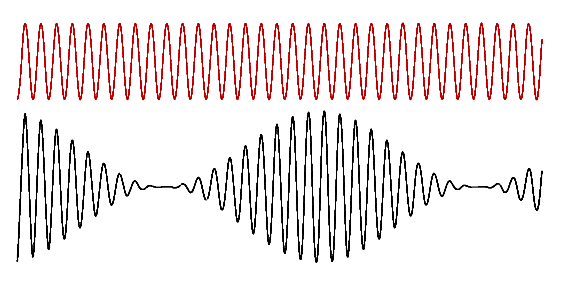Amplitude Modulation Overview
Amplitude modulation is accomplished by varying the amplitude of a carrier waveform according to the amplitude of a modulating waveform. The general equation for applying amplitude modulation to a waveform is:
AM(t) = [M(t) + 1] × C(t),
where C(t) is the carrier waveform, M(t) is the modulating waveform, and AM(t) is the modulated signal.
This class driver provides modulating waveform property definitions that must be followed when developing specific instrument drivers. The carrier waveform is defined as the waveform that the function generator produces without any modulation. The modulating waveform is defined by the following properties:
Waveform TypeThe overall "shape" of one period of the modulating waveform. This class driver defines five modulating waveform types: Sine, Square, Triangle, Ramp Up, and Ramp Down.
FrequencyThe number of modulating waveform cycles generated in one second.
Modulation DepthThe extent to which the modulating waveform affects the amplitude of the carrier waveform. This value is expressed as a percentage of total modulation.
At the maximum peak of the modulating waveform, the amplitude of the output signal is equal to (100.0 + Modulation Depth) percent of the carrier signal amplitude. At the minimum peak of the modulating waveform, the amplitude of the output signal is equal to (100.0 Modulation Depth) percent of the carrier signal amplitude. At a modulation depth of 0 percent, the modulating waveform has no effect on the carrier waveform. At a modulation depth of 100 percent, the amplitude of the output signal varies between 0.0 V and twice the amplitude of the carrier signal.
The following diagram illustrates the effect of amplitude modulation on a carrier signal, and the effect on the output signal of varying the modulation depth.
